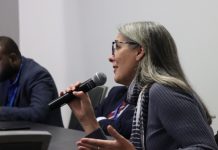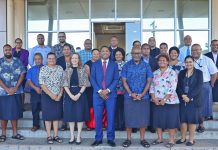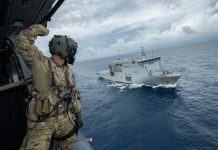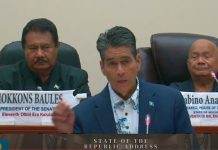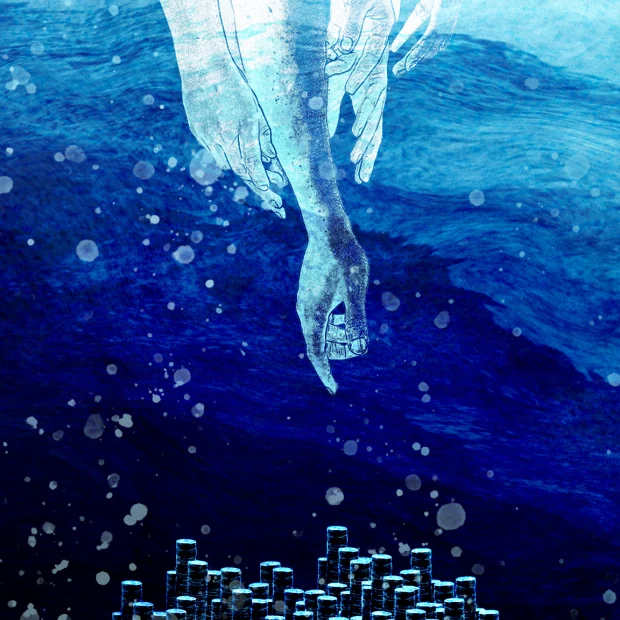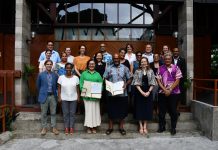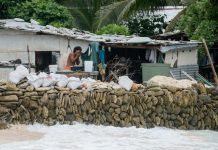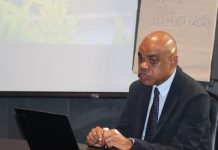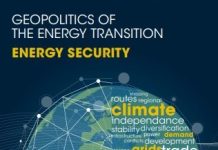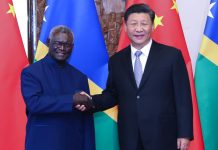By Sherryn Groch
Thirty years ago, Australian geologist Ray Binns threw a camera over the side of his science ship and hit a “goldmine” on the bottom of the sea. A kilometre down, his camera had slammed into a hydrothermal vent chimney: a tall spire of copper and gold reaching up from a seafloor hot spring.
Binns had spent five years searching the Pacific for them but that day, to outrun a cyclone, he ordered the CSIRO’s Franklin vessel into the Bismarck Sea off Papua New Guinea. And, suddenly, the ship’s instruments told him they were right above a vent.
“We call them black smokers,” explains Binns. When he winched his camera back on deck, chunks of copper and gold were still lodged in its casing. The yield was unusually pure – with 15 to 30 times as much metal as ore mined on land.
“It’s bloody El Dorado,” he recalls shouting. “Bonanza figures.”
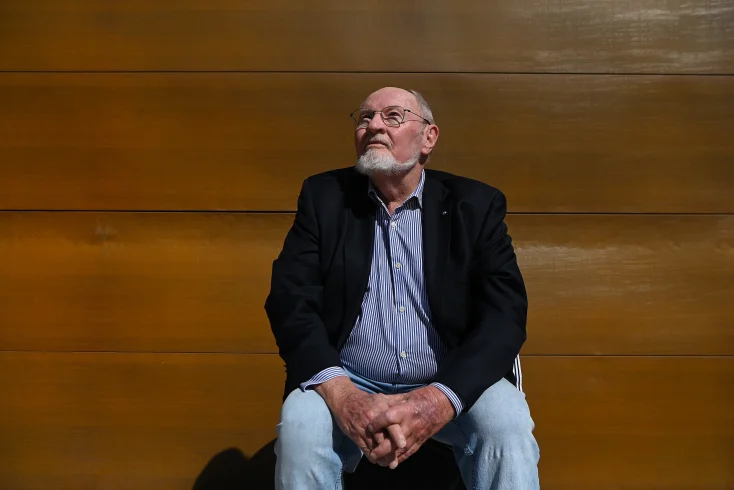
The strange underwater world Binns stumbled upon that day – where “immortal” jellyfish glow and whales dive to bone-crushing fathoms to hunt giant squid – may soon become the site of the world’s first deep-sea mine.
This masthead has discovered that the PNG government is now in talks with a corporation partly owned by a sanctioned Russian oligarch to revive a project to mine Binns’ smoker.
If production begins next year as planned, it would kickstart the race to mine valuable metals from the deep – and Australians are among the key players pushing for this new frontier to open.
The prize is billions of dollars in metals on the seafloor, including those urgently needed for the clean energy transition.
There are two routes to this treasure: deal with nations in their territorial waters, such as PNG, or stake claims in international waters where the rules are still being thrashed out.
The latter is seen as the mother lode – the high seas cover about half the planet. In the 1980s, nations agreed that the riches there are the world’s “common heritage”, to be used for “the benefit of mankind”.
Over decades of negotiation, high-value areas of this seabed have been set aside for developing countries.
Now the UN is poised to open these waters to mining. But an investigation by this masthead has found a small group of companies are likely to reap the greatest rewards.
These companies have partnered with small island nations to access their seabed claims. And the same people are behind many of them, including a shipping magnate who tried to name the world’s biggest ship after his Nazi father; an Australian mining executive convicted of insider trading; and a man once called Russian president Vladimir Putin’s “favourite oligarch”.
High-stakes decisions about one of the most important places on Earth are now being made behind closed doors at the International Seabed Authority (ISA) – a little-known but powerful UN regulator with a competing mandate to oversee deep-sea mining and protect its unique environment.
If something goes wrong, scientists warn, everything from the planet’s carbon cycle to our seafood could be affected.
“It’s a Wild West,” says Sandor Mulsow, a marine geologist who held top positions at the ISA before leaving in 2019. “The seafloor is all of our common heritage. But a monopoly is forming.”
At the front of the pack is Nasdaq-listed The Metals Company (TMC), run by Australian chief executive Gerard Barron. It has contracts for about half of the seabed that the ISA has so far allocated to developing nations (via partnerships with the island nations of Nauru, Tonga and Kiribati) and hopes to start mining the Pacific in 2025.
The company has spent millions of dollars on environmental research, even contracting Australia’s CSIRO to develop a management plan, and promises investors billions in profit. It also has a colourful history, including an attack by a short-seller in 2021 that triggered lawsuits from shareholders, and an SEC investigation. No public findings of wrongdoing have yet been made.
This masthead has now discovered that The Metals Company’s major investor and partner, the private shipping giant Allseas, has its own ISA licence (through a subsidiary sponsored by Jamaica).
Allseas’ ultimate ownership of the licence hadn’t been disclosed, not even by the ISA in public documents. Together with its large stake in TMC, Allseas is linked to nearly two-thirds of the seabed so far allocated for developing nations. “We plan to develop our licence block parallel to our endeavours with [TMC],” an Allseas spokesman confirmed.
Last year, Tuvalu withdrew its backing for a licence bid by company Circular Metals, after the ISA failed to answer questions about its ownership.
This masthead confirmed that TMC’s founder, Australian David Heydon, is also the majority shareholder and financier of Circular Metals.
“It’s like the Gulf of Mexico,” says Heydon of the new deep-sea frontier. “OK, there was one prospector at first, but once they showed how to do it, others moved in, costs fell and an industry sprung up. We’re first so it’s hard, but we’re also first.”
TMC’s Barron is sometimes styled as Australia’s Elon Musk. He’s cast deep-sea mining as critical to both accelerating clean energy and lifting island nations out of poverty.
Some economists expect electric battery metals will become as important as oil is today as demand soars, and Barron argues these metals can be harvested with less impact under the sea than on land, where reserves are dominated by China, Russia and Africa, and mines run off the back of deforestation (and sometimes child labour).
TMC estimates the haul from its claim in the Pacific alone could electrify 280 million electric cars, about the size of America’s entire car fleet.
The risks are high too. The extreme conditions of the deep are often compared to space, and scientists fear storms of sediment stirred up by mining machines could spread for tens of kilometres, smothering important ecosystems. Toxic metals and even radioactive particles could be released back into the food chain.
Sir David Attenborough and other experts say it’s “beyond reason” to open the deep for mining until more is understood about the impact, and pressure is building on Australia to join more than 20 nations (and about 800 scientists and experts) calling for a global moratorium.
Speaking to this masthead as the ISA met in July, Barron laughed off the Musk comparison as “ridiculous”. “But am I pushing new frontiers? Sure,” he said. “It’s not easy to get a new industry started and disrupt another one at the same time.”
The keys to the kingdom
Barron’s dive into the deep began more than two decades ago when he invested in Nautilus, the Australian start-up that secured the world’s first deep-sea mining licence. To Barron, it sounded like the start of a mining revolution.
Nautilus was chasing copper and gold on Binns’ hydrothermal vents in PNG.
Back then, Binns’ discovery had made headlines around the world. But when he returned to shore in 1993, only one journalist came to see samples from this “Broken Hill beneath the sea”: Sydney mining writer Julian Malnic.
Binns didn’t realise that Malnic was also a geologist. Or that, within months of photographing his research, Malnic would stake a claim for the very same smoker with the PNG government – founding Nautilus.
“I used Ray’s charts, everything, but I didn’t tell him,” says Malnic, whose great-uncle was an explorer in the Pacific. “Ray was really upset until he realised it was a great idea. I couldn’t believe no one else was moving on this.”
Still, Malmic did return to offer Binns and the CSIRO a stake in the venture. “It wasn’t the done thing then, so we had to say no,” says Binns.
Binns went on to work for Nautilus as a science adviser, diving down in submersibles through a ring of undersea volcanoes to map PNG’s particularly rich metal deposits.
Malnic also staked claims for smokers in Tonga’s coastal waters, and for polymetallic nodules (containing key battery metals) out in the high seas.
“The Tongan mining act was only a page and a half long then,” Malnic recalls. “They gave me the keys to the kingdom, their office, one weekend, sweet people. And I literally wrote up the mining forms myself, covering a huge tract of seafloor. I put in a fee for US$300 dollars Tongan for each licence; I just made it up.”
He says the Tongan government later “reverse-engineered its mining act” to grant his applications.
But Nautilus went bust in 2018, costing the PNG government AUD$170 million (US$108 million) in lost investment and sparking fury from locals.
By then, Barron, Malnic and Heydon had all cashed out. Barron and Heydon, along with other Nautilus figures, were chasing polymetallic nodules in international waters through a new company, TMC, which picked up some of those original Nautilus licences.
“If we’re going to do all the heavy lifting starting an industry, I thought we should position ourselves with some of the key locations for those offshore resources,” says Heydon.
Meanwhile, SEC filings reveal that when Nautilus collapsed, it was largely bankrolled by two shareholders – Omani oil billionaire Mohammed Al Barwan and oligarch Alisher Usmanov, one of Russia’s richest men.
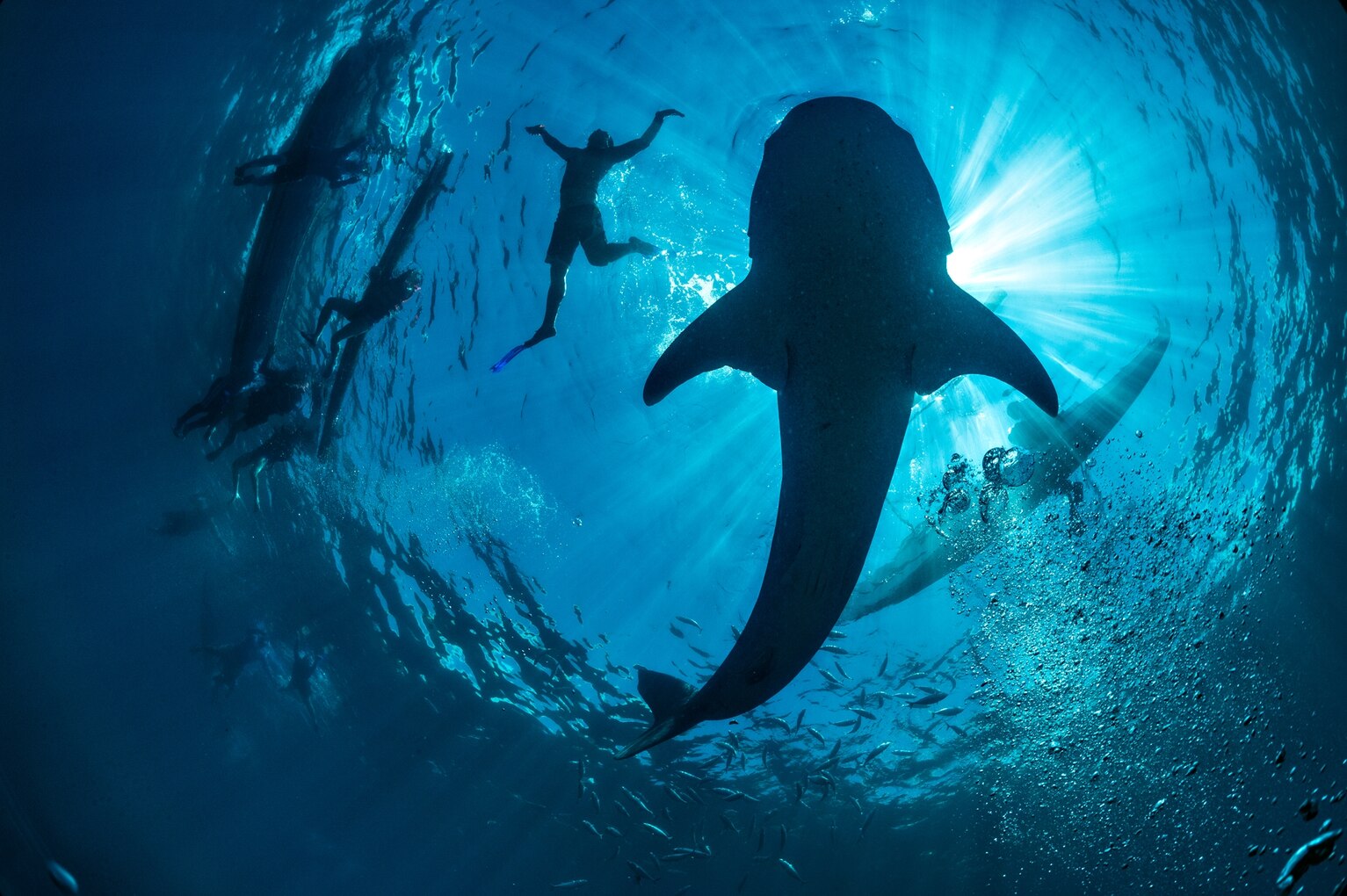
Sharks and oligarchs
Solwara warrior Jonathan Mesulam lives only 25 kilometres from the old Nautilus site Solwara-1 on PNG’s New Ireland coast. He recalls how its early exploration work chased sharks out of the bay.
“The sea is what has kept us for generations,” he says. “The cost of mining was just too high for a quick buck.”
Now the sharks are back. But so is Nautilus. Locals and conservationists fear PNG is now being used as a guinea pig on a venture that could disrupt the wider marine food chain Pacific nations rely on – and potentially funnel profits back to sanctioned oligarchs.
Today, the project is completely owned by a private group called Deep Sea Mining Finance (DSMF), which bought Solwara-1 from the corporate wreckage of Nautilus.
The PNG government has confirmed that DSMF plans to start testing this year – and production the next, under the project’s original licences.
DSMF is headquartered in tax haven the Virgin Islands, and its chief executive is listed as Australian Chris Jordinson, who was convicted of insider trading in 2014. But this masthead can reveal that the company was created by Metalloinvest and USM Holdings, the sanctioned companies of the oligarch Usmanov, as well as Al Barwani’s MB Holding, in 2017.
PNG Mining Minister Sir Ano Pala told this masthead that he wasn’t personally aware of who owned DSMF but that some further checks and environmental approvals may be needed before mining begins.
“The main thing is we want them to explain how they will pay back the money they lost us, hundreds of millions,” he said. Potentially doing business with a sanctioned oligarch may “be a bigger issue for the government to look at,” he added.
References to USM and Metalloinvest’s ownership of DSMF were scrubbed from its website in April 2022 (shortly after Usmanov was sanctioned by the United States, Australia, the EU and Britain over the war in Ukraine), yet official meeting notes from recent talks between DSMF and the PNG government leaked to this masthead suggest the oligarch’s companies still own half.
Court records also list another key figure at DSMF: Matthias Bolliger, who was disqualified as a director by authorities on tax haven the Isle of Man in 2021 for money laundering breaches, and flagged in the Panama Papers for his links to Usmanov.
In an “information memorandum” prepared for the PNG government, DSMF claims the undersea mine will pull up 182 kilotonnes of ore annually, running 300 days a year, and that new target zones have been identified for further mining beyond the original site, creating local jobs.
Heydon secured US$100 million in investment from Usmanov when he was at the helm of Nautilus, alongside other mining giants such as Anglo-American.
“Usmanov owned half of Russian iron ore and steel, and brought a lot to the table on shipping,” Heydon says. “He only had one board seat then, so his influence was limited and no money flowed back to him in the end. Still, now [after Usmanov’s sanctions], you’d think the PNG government would be concerned.”
Who’s keeping watch on the high seas?
If the smoker in PNG is set to be the first deep-sea mine, it is the high seas where the real money will be made, even as the rule book is still being written.
Companies such as TMC have their eyes on a huge stretch of ocean floor between Hawaii and Mexico that is so studded with polymetallic nodules it is said to hold more rare metals than all the reserves on land.
Countries at the UN’s ISA need to adopt a deep-sea mining code before any commercial mining in international waters can begin.
After the ISA council’s latest sitting, the secretariat conceded the code wouldn’t be adopted until 2025 (rather than this year as it had flagged), sending TMC’s share price into a nose dive.
But, even with that delay, some countries worry that the ISA secretariat is itself trying to push through mining rules without robust environmental safeguards and company oversight – or even a fair means of divvying up the proceeds “for the benefit of mankind”.
ISA observers including NGO environmental lawyer Duncan Currie say a number of country delegations received “suggested talking points” from the secretariat encouraging them to raise the urgent need for battery metals during council debate on the code, in an apparent attempt to influence deliberations.
“Especially countries new to the ISA,” says Currie. “The dot points they were given all steer the debate towards the need for mining.”
Diplomats from Germany, Costa Rica and elsewhere have accused ISA secretary-general Michael Lodge of stepping out of line in his efforts to get the code through the council.
Lodge has played down scientific concerns about mining and appeared at promotional events for companies (including in an ad for TMC in a company hardhat), but has defended the authority’s neutrality and integrity. The ISA did not answer an extensive list of questions and declined an interview request for Lodge.
Previously, Lodge has noted that the ISA was created to open the deep sea to mining, but has called it “the slowest gold rush in history” because of the authority’s careful “checks and balances”, especially concerning environmental protection, praising companies for their investment in research and technology.
“There are many complicated and delicate trade-offs to be made,” Lodge has said of environmental concerns, stressing the metals required for the green energy transition need to come from somewhere.
Now an obscure rule could mean companies may no longer have to wait for the mining code to get mining licences. As of July, the ISA’s operational arm – the Legal and Technical Commission (LTC) – can consider commercial, not just “exploratory”, applications.
First to use the loophole will be TMC, after its sponsoring state Nauru opened it with a notification two years ago. TMC says it will apply next year.
If the LTC grants the application, the ISA’s structure will make it difficult for country delegates to rescind the licence.
The ISA was designed that way to avoid politicising mining, lessening the power of country blocs, says marine law researcher Pradeep Singh. But in practice, he says, it has allowed key decisions to be made behind closed doors by a powerful few – lawyers and geologists on the Legal and Technical Commission, sometimes with ties to industry.
The ISA charges half a million dollars for a licence, and hasn’t rejected an application yet.
“And the same people are behind many of these claims,” says Singh. “It was thought states would be the ones that monopolise this – you know, China having five contracts – but I think what’s more dangerous is company monopolies.”
And once they get a contract, control can shrink down even further, he says, as ownership is changed or offtake agreements and subsidiaries are structured.
“The seabed could very well end up in the hands of a few.”
So far, the LTC has refused to name or penalise companies not complying with the requirements of their exploration, such as environmental surveying. It has also rejected requests from diplomats to hold open meetings. When it approved its most recent licence, to Blue Minerals Jamaica, for example, the ultimate owner Allseas was referred to publicly only as an unnamed “multinational enterprise” with offshore experience.
Sandor Mulsow sat in closed-door LTC meetings for years and thinks its public reports were not just brief – two or three pages to summarise reams of documents – they were watered down.
“Our final warnings to companies became, ‘The LTC notes not all contractors have submitted data accordingly,’” he says. “I thought it was my English being bad at first.”
In 2016, Mulsow and another ISA scientist sounded the alarm over the quality of contractor environmental surveys, concerns echoed in an audit of the ISA that year that found the authority was “not yet fulfilling its obligations to ensure that activities … are carried out for the benefit of mankind”.
By 2016, some contractors had collected just one biological sample for every 10,000 square kilometres of their licence area. Mulsow recalls a company that included “amphibians” in its species survey.
“There are no frogs in the deep sea,” he says. “When I rang them, they said it was a mistake and that whole column of numbers vanished. Where did they come from?”
That company was not TMC, which has just uploaded another large tranche of environmental data – more, it says, than any other licence holder.
But, in the past, data has flowed both ways between those at the company and the ISA. Documents leaked to The New York Times show that, starting in 2007, the ISA sent confidential data to key people at Nautilus (now at TMC) – information meant to give developing nations an advantage finding the most mineral-rich mining sites.
Heydon admits his memory is hazy on how Nautilus got the data first, but he says, “We weren’t given any confidential information that wasn’t available to others if they’d asked, as far as I understand.”
When asked about a potential monopoly forming, Heydon notes only a handful of companies typically have the skills for complex offshore work. “You turn to these Halliburtons of the world. Now Allseas has developed more deep-sea expertise, at its own cost, so countries will partner with them because they know the chance of success is higher.” Still, he adds, “there’s plenty of room out there”.
Benefit of mankind?
The deep-sea rush was meant to be different. But Currie and Singh say deals intended to give poorer countries a stake in mining have instead put companies in control.
“Literally, they just need an office and a business registered there,” says Singh. TMC’s subsidiary NORI has an office in Nauru, for example. “But if something goes wrong, TMC can cut the rope to NORI and leave.”
When NORI’s licence was approved by the ISA in 2011, it said it was a Nauruan company not owned or affiliated with any foreign entity or person. Yet, Heydon confirmed that he was on NORI’s board of directors at the time, and that TMC already provided funding. Heydon even signed its licence agreement with the ISA.
Currie, Singh and other experts view these kinds of arrangements as predatory.
Barron insists they will benefit TMC’s partner nations, who would otherwise not have the technology or money to develop the new industry.
“If you’re an island in the middle of the Pacific, watching the sea levels rise, this is an opportunity that just wouldn’t come your way,” he says.
Most of Nauru is itself uninhabitable, stripped by the phosphate mining of colonial powers in the last century. Heydon says he saw in Nauru a chance to put the ISA vision of “benefiting mankind” into practice, helping “mining give back to the tiny nation without actually touching it”.
That giving back comes in the form of royalties to the sponsoring country and the ISA. TMC’s royalty deal with Nauru has not been disclosed, but Barron says it is a little more than the $2 a tonne previously quoted by a Nauruan official, which worked out to less than 1 per cent of expected profit.
“It’s less than five dollars” a tonne, Barron concedes.
Even after an extra royalty (probably between 2 and 10 per cent) is paid to the ISA and its member states, the lion’s share of profit will still go to companies, not nations.
Nauru’s deal with TMC appears to also waive corporate tax, usually about 25 per cent. Barron says that Nauru and TMC have just put it “on hold”.
“We’re back negotiating that amount now,” he says. “Because normally, when a country taxes someone, it’s for services provided. Whereas Nauru, we don’t plan to process there or put any infrastructure there other than we have an office there.”
After tax, TMC expects its profits from the claim with Nauru to total US$30 billion over its life.
Barron argues that the alternative is “a government-type entity” mining. “And these assets are typically more successfully developed in private hands. But to do that, you’ve got to attract a lot of capital and offer [a return].”
Barron sees “the benefit for mankind” as more than profit, but the nodules themselves – battery metals that will turbocharge the clean energy transition and, once in the system, can be recycled. He keeps one in his pocket at all times so he can show people the ancient rock.
Still, some economists are sceptical that deep-sea metals will ever rival land mining, or even offer the right chemistry mix, as battery technology evolves.
Currie, meanwhile, worries it will be developing nations left with costly clean-ups if something goes wrong.
The Nautilus failure stands as a warning for the Pacific, says Australian environmental campaigner Helen Rosenbaum, who has worked across the region. “I can’t believe PNG is considering risking that again.”
Financial expert Andy Whitmore has been tracking what he calls the “quiet privatisation of the seabed” for Rosenbaum’s NGO Deep Sea Mining Campaign, and says prospectors “can make a career out of failure”.
“They’re selling potential,” he says. “Didn’t Twain say ‘a gold miner is a liar standing over a hole in the ground?
SOURCE: SMH/PACNEWS


